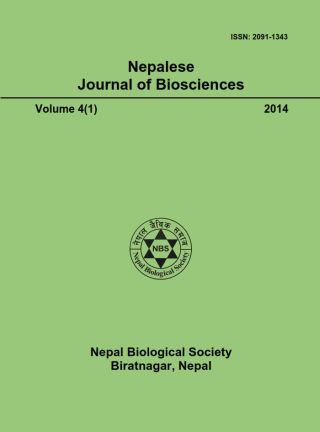Seasonal species distribution and dominance in grazed Terai grassland of Budhanagar, Nepal
DOI:
https://doi.org/10.3126/njbs.v4i1.41687Keywords:
Biomass, density, forbs, grasses, IVI, legumesAbstract
Assessment of seasonal distribution and dominancy of herbaceous species of a grazed grassland of Budhanagar, eastern Terai region of Nepal was carried out in 2010. A total of 33 species: grasses (10), sedges (5), legumes (4) and non- legumes (14) were recorded with distinct seasonal occurrence. Most dominant species throughout the year were: Chrysopogon aciculatus (biomass 91.0-1720.5 g/m2; IVI 78.8-99.8 ); Desmodium triflorum (biomass 30-679.3 g/m2; IVI 13.8-41.7) and Imperata cylindrical ( biomass 12.0-83.3 g/m2; IVI 20.7-34.6). Maximum total community biomass (3650.7 ± 19.1 g/m2) was recorded in rainy and minimum (175.0 ± 4.1 g/m2) in summer season. Maximum percent contribution by biomass and IVI of grasses was in winter season (90.3 and 76.2); sedges (17.1 and 19.0) and legume (12.6 and 15.0) in rainy season and that of non-legume in summer season (7.5 and 15.7) to the total community biomass and IVI, respectively.




